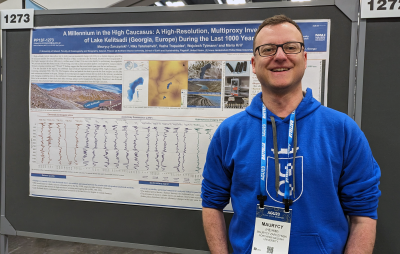
Dr Maurycy Żarczyński at the American Geophysical Union Fall Meeting 2023 - San Francisco
Is the ‘megadrought’, which took place about 4 200 years ago, an event of global significance? According to the International Commission on Stratigraphy, yes, while according to the authors of the publication that appeared in Nature Communications, no. Among the latter is dr Maurycy Żarczyński, who recently returned from an 18-month internship at Northern Arizona University. Apart from the prestigious publication, what did the Bekker NAWA scholarship trip give the young scientist? New skills, a broadening of horizons, and... a change in weight. We invite you to read the interview!
Marcel Jakubowski: - In your publication, you suggest that the Holocene division established in 2018 by the International Commission on Stratigraphy should be further revised. What are the reasons for these dynamic changes in the division of the youngest geological epoch?
Dr Maurycy Żarczyński: - 11,700 years ago, the Pleistocene, or the so-called Ice Age, ended and the Holocene - the geological epoch that continues today - began. This period has been divided in many ways: either from a biological perspective, a geological perspective, or the perspective of climate change that we study. The current division established in 2018 is based on two events that some scientists believe were global. The first occurred about 8 200 (8.2k) and the second 4 200 (4.2k) years ago. Global climate change is said to have occurred then. Some studies indicate that the Earth was much colder, warmer, wetter or drier during these periods. We try to confirm these events using paleoclimatic data from around the world. For example, in Poland, we have found information in lake sediments that indicate a climatic fluctuation just about 8 200 years ago, similar phenomena have been recorded by scientists in the United States, Africa, or Asia... It is different for the 4.2k event, which we write about in our publication. We emphasise that while the 8.2k event is global, the 4.2k event may have been less significant than previously assumed.
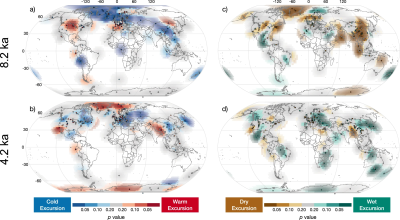
Spatial variety of the 8.2k i 4.2k events - source: Nature Communications
- Among other things, the publication highlights that some of the articles on the 4.2k event describe, in fact, different events hundreds of years apart. What other inaccuracies have you found in these studies?
- The first problem lies in either a lack of material or an inaccurate choice of methodology to determine the chronology. Any chronology in our research is fraught with uncertainty. We give a date, but we also have to write down the range of potential error with it - sometimes tens, sometimes hundreds of years. There is no ideal method of measurement, no ideal method of sampling, sample preparation, etc., so there is uncertainty at every stage of research. There are certain methods we should not use to analyse certain periods, some fit older events, others fit younger ones.
Another problem is the resolution of environmental archives. For example, if we take oceanic sediment and thus record a climate, hydro-climatic or environmental signal, it becomes somewhat ‘blurred’. Some archives do not record the signal at as high a resolution as we would like. If we have one point that informs us of what happened a thousand years ago, and another that informs us of what took place 2,000 years ago - we cannot suggest what happened between the two points. That would be too averaged information. If we don't have high resolution, which is the problem with some of the archives we write about in the publication - then we have to reject them because there are too few data points around the events described.
Still another problem is that there are a lot of archives, but they do not necessarily reflect the given environment, climate and hydro-climate. We may have a reconstruction of environmental change that relates to afforestation, but the authors do not show how these data relate directly to climate. We can reconstruct many things that happened in the past, but we need to justify why a parameter reflects the climatic conditions at that time. When analysing the research conducted around the 4.2k event, we had to discard a lot of data for this reason as well.
It is also worth pointing out that if more and more people are writing about the 4.2k event, more scientists may start subconsciously looking for variability in this very period. Once the formal division of the Holocene emerged, scientists naturally began to refer to it and justify it... and it may not be correct.
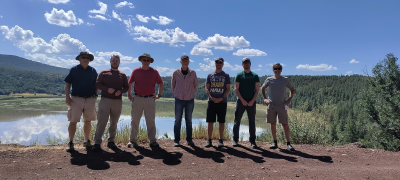
- Your publication questions the division established by the International Commission on Stratigraphy. Have you discussed this aspect of the paper with the other authors?
- Yes, I have; we have talked about, among other things, that we might run into reviewers who are very connected to the idea of a 4.2k event and we will have a problem. You could say we're poking an anthill with a stick, but that's also normal scientific discourse. We cannot accept everything that has been accepted in the past, we are just analysing, questioning, looking for the truth. Maybe in 10-15 years someone will have collected twice as much data as we have in our publication, used the same methodology as we have, and it will turn out that the 4.2k event had global significance. What we write about in the publication is the state of our knowledge today - and it suggests that we are not talking about a global event. We discuss it at conferences, some are in favour of such a theory, others against it, and they are entitled to do so. Some would certainly find it hard to accept such a state of affairs because they have built part of their careers on the 4.2k event.
- A publication in Nature Communications is probably not the only result of those 18 months spent at Northern Arizona University (NAU). What else did this postdoctoral fellowship give you?
- Definitely a change in weight; before I left, things were not so good (laughs). I went to NAU mainly to get training in using hyperspectral data from an identical scanner to the one we have in ACB. I spent a lot of time working with it, learned a lot of new tools, and greatly developed my knowledge of the R programming language, which in this case we use to process and handle the scanner data. Academically, I saw a different way of research and a slightly different working culture, for example, one of the co-authors of our paper was an undergraduate student, a girl studying the equivalent of our bachelor's degree. I am very grateful to everyone who welcomed me there - both the researchers and my hosts. Flagstaff, where I was staying, is a beautiful town situated 2,100 metres above sea level, with mountains all around, desert, lots of ski lifts...
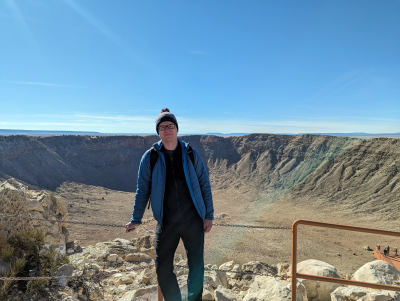
- And yet you decided to come back...
- I knew I would come back. I like Poland, we have our problems, but I like our country. Going to the USA was certainly an interesting adventure, but here is my Alma Mater and I would like to work here for a long time. I especially like the Tricity, as long as conditions allow me, I want to be here.
- What knowledge do you need to have in order to study changes in geological epochs accurately?
- Nowadays, studies of the climate past cannot be carried out alone. You need knowledge of the Earth's orbital parameters (e.g. the rotation of the Earth or the tilt of the Earth's axis), and you need to be aware, for example, of how aerosols disperse in the atmosphere, how a volcanic eruption can temporarily affect climate change. You need experts who know meteorology, climatology, but you also need specialists in palaeobiology and palaeoecology, that is, people who, for example, deal with pollen analysis and can tell you from that how the vegetation has changed in the past. Someone else will deal with pigments or geochemistry, as we study the cycles of the elements. We can go on and on, because everything we study about climate and the environment now, we also try to study thousands of years ago. Therefore, nowadays, a single analysis does not mean a publication; it takes the cooperation of qualified specialists to adequately reconstruct the conditions of a given period.
- The Holocene is, among other things, an important geological epoch for Poland, because it was then that the Baltic Ice Sheet transformed into the Baltic Sea. How else did the terrain on which our country lies change during this period?
- The north of Poland was covered by the last Pleistocene glaciation. As a result, we have here, among other things, moraine uplands and a typical lake district landscape, i.e. thousands of lakes. During the retreat of the ice sheet, the formation of soils began and, as the climate warmed and conditions improved, the vegetation began to develop. This also meant that people began to move north and inhabit these areas.
- Why are certain regions of Poland full of lakes and others not so rich in these bodies of water?
- This is a direct result of the history associated with glaciations. Pomerania is an area of the last glaciation. During the recession (retreat or disappearance) of the ice sheet, huge lumps of dead ice were buried in the depressions of the land, which separated from the main ice sheet and then began to melt. The ice sheet left behind numerous depressions, or hollows, which in very many cases became lakes. If this ice had not been there, something else would have filled the depression and the lake would not have formed. The extent of the maximum of the last glaciation is not synchronous in Poland - in the West it is further south, and in the East this boundary is shifted further north. The whole landscape of northern Poland, which we associate with lakes, is connected precisely with the influence of the last glaciation, i.e. with the Vistula glaciation.
- Thank you for the interview.
- Thank you.
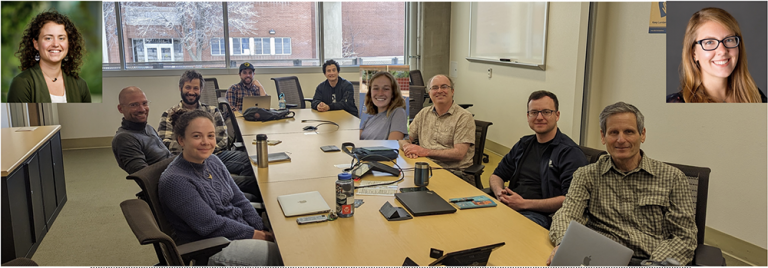
Members of the research team: Stéphanie Arcusa, Leah Marshall, Cody Routson, Dave Edge, Chris Hancock, Georgia Roberts, Michael Erb, Maurycy Zarczynski, Darrell Kaufman and Hannah Kolus. Not in the picture: Nick McKay. Source: news.nau.edu
